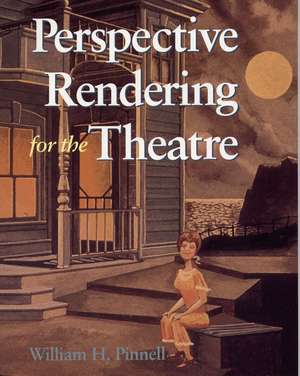Perspective Rendering for the Theatre
Autor William Pinnellen Limba Engleză Paperback – 28 noi 1996
William H. Pinnell first issues an "invitation to investigate the magic of perspective and explore its wondrous surround," then escorts the beginning as well as the advanced student through the complex process of artistically conveying scene designs via the scenographic drawing. Step by step, he illustrates the principles of perspective that apply to stage design. Starting with a brief history of perspective, he furnishes all of the information designers will need to transform a blank surface into a unique expression of theatrical space. As Pinnell makes clear, a stage setting must be fully planned far in advance of its actual construction. Each designer must have a picture of how the setting will appear when it is ready for opening night. The scenic designer must then be able to render that picture, to communicate his or her ideas through a series of initial sketches that, combined with directorial consultation, eventually evolve into an approved plan for the actual setting. Many of these plans take the form of working drawings—floor plans, elevations, and the related schematics necessary for the shop staff to construct the design. Pinnell insists that as closely as possible, the model—the graphic and tangible rendering of the designer’s vision—must reflect what the actual stage set will look like when the audience sees it in the performance. His concern is to show how one faithfully and accurately represents the actual, finished stage design through theatrical rendering.
Pinnell achieves this goal through an introduction and six chapters. He provides the historical background in a chapter titled "The Perspective Phenomenon," which covers preclassical Greece, Greek and Roman notions of perspective, and the concepts of the Italian Renaissance. "The Perspective Grid: Learning the Basics" deals with drafting tools, drawing the perspective grid, and the basics of measuring on the perspective grid. "The Perspective Grid: Expanding the Basics" discusses transferring a simple interior setting, plotting curves, and creating levels. "The Perspective Grid: Variations" analyzes the thrust stage, the raked stage, and the two-point perspective grid. "Coloration and Form" explains varied backgrounds, color media, and rendering with gouache. Finally, "Presentation" explains protection, framing, duplication, and the portfolio.
Except for the intricacies of the human anatomy, there is nothing a designer must draw scenically that is not covered in this book.
Except for the intricacies of the human anatomy, there is nothing a designer must draw scenically that is not covered in this book.
Preț: 243.26 lei
Preț vechi: 339.34 lei
-28% Nou
Puncte Express: 365
Preț estimativ în valută:
46.55€ • 48.31$ • 38.91£
46.55€ • 48.31$ • 38.91£
Carte indisponibilă temporar
Doresc să fiu notificat când acest titlu va fi disponibil:
Se trimite...
Preluare comenzi: 021 569.72.76
Specificații
ISBN-13: 9780809320530
ISBN-10: 0809320533
Pagini: 192
Ilustrații: 177
Dimensiuni: 178 x 229 x 10 mm
Greutate: 0.36 kg
Ediția:1st Edition
Editura: Southern Illinois University Press
Colecția Southern Illinois University Press
ISBN-10: 0809320533
Pagini: 192
Ilustrații: 177
Dimensiuni: 178 x 229 x 10 mm
Greutate: 0.36 kg
Ediția:1st Edition
Editura: Southern Illinois University Press
Colecția Southern Illinois University Press
Notă biografică
William H. Pinnell, an associate professor of theatre at the University of Windsor, is the author of Theatrical Scene Painting: A Lesson Guide, also available from Southern Illinois University Press. He has been teaching theatrical rendering for nearly a quarter of a century.
Recenzii
"What was moments before a dark cavernous room quickly becomes an intimate personal voyage illuminated by magic and light. Robert Sherwood spoke for the audience when he said that ‘theatre is the dwelling place of wonder.’ To a very large degree, the stage setting provides the primary visual support for that place of wonder, since it is the environment for the action of the play’s events."—William H. Pinnell, from the Introduction
